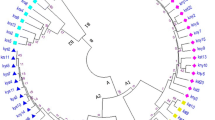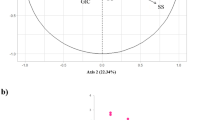Summary
The characterization of 39 Italian ecotypes and cultivars of Triticum turgidum L. spp. dicoccum Shrank ex Schübler (emmer wheat) was performed utilizing agro-morphological and molecular tools. Emmer wheat is a hulled species which grows wild in the Near East and is still cultivated in the Mediterranean Basin. Due to its characteristics, in Italy it is cultivated mainly in marginal lands of central and southern Italy, where local varieties, adapted to the natural environment where they originated, are used. Emmer wheat cultivation has been drastically reduced during the last century as a consequence of its low yield. Nevertheless, more recently, its agronomic and nutritive values, together with its use in health food products, made its cultivation economically viable in the marginal lands with a parallel increase of the cultivated area which is now more than 2000 ha.
In the present paper the results of morphological evaluation, carried out in an experimental field in central Italy using a randomized block design with three replications, and molecular characterization are reported. The analysed material showed distinctive molecular traits and the existence of a huge amount of diversity not only between varieties, but also within them. When the accessions were clustered utilizing their genetic distance, the clusters were not always in agreement with the accessions origins. The obtained results gave information that can be useful for: (i) future registration of material, (ii) germplasm conservation and (iii) use of this valuable source of emmer germplasm for future breeding programmes.
Similar content being viewed by others
References
Barcaccia, G., L. Molinari, O. Porfiri & F. Veronesi, 2002. Molecular characterization of emmer (Triticum dicoccon Schrank) Italian landraces. Genet Res Crop Evol 49: 417–428.
Blanco, A., B. Giorgi, P. Perrino & R. Simeone, 1990. Risorse genetiche e miglioramento della qualità del frumento duro. Agric Ric 114: 41–58.
Codianni, P., G. Galterio, N.E. Pogna & N. Di Fonzo, 2000. Mosè e Padre Pio due nuovi genotipi di farro (Triticum dicoccum Schublcon caratteristiche qualitative di pregio. L'Informatore Agrario 24: 37–38.
D'Antuono, L.F., 1989. Il farro: Areali di coltivazione, caratteristiche agronomiche, utilizzazione e prospettive colturali. L'Informatore Agrario 24: 49–51.
D'Antuono, L.F. & M. Minelli, 1998. Yield and yield components analysis of emmer wheat (Triticum dicocum Schubler) landraces from Italy. In: A.A. Jaradat (Ed.), Proceedings of the 3rd International Triticeae Symposium, May 4–8, 1997, Aleppo Syria. Science Publisher Inc., USA, pp. 393–404.
Damania, A.B., S. Hakim & M.Y. Moualla, 1992. Evaluation of variation in Triticum dicoccum for wheat improvement in stress environment. Hereditas 116: 163–166.
Dixon, W.J. & R. Jennirich, 1990. Stepwise regression. In: W.J. Dixon, M.B. Brown, L. Engelman & R.I. Jennrich (Eds.), BMDP Statistical Software Manual, University of California Press, Berkeley, USA, pp. 359–394.
Dvorak, J., P.E. Mc Guire & B. Cassidy, 1988. A apparent sources of the A genomes of wheats inferred from polymorphisms in abundance and restriction fragment length of repeated nucleotide sequences. Genome 30: 680–689.
Eujayl, I., M.E. Sorrells, M. Baum, P. Wolters & W. Powell, 2002. Isolation of EST-derived microsatellite markers for genotyping the A and B genomes of wheat. Theor Appl Genet 104: 399–407.
Figliuolo, G. & P. Perrino, 2004. Genetic diversity and intra-specific phylogeny of Triticum turgidum L. subsp. dicoccon (Schrank) Thell. revealed by RFLPs and SSRs. Genet Res Crop Evol 51: 519–527.
Galterio, G., P. Codianni, G. Novembre, C. Saponaro, N. Di Fonzo & N.E. Pogna, 1998. Storage protein composition and technological characteristics of F6 lines from the cross Triticum turgidum spp. Durum × Triticum turgidum spp. dicoccum. In: Proceedings of the 9th International Wheat Genetics Symposium, Saskatoon, Canada, Vol. 4, pp. 148–150.
Heun, M., R. Schäfer-Pregl, D. Klawan, R. Castagna, M. Accerbi, B. Borghi & F. Salamini, 1997. Site of einkorn wheat domestication identified by DNA fingerprinting. Science 278: 1312–1314.
Hodgkin, T., R. Roviglioni, M.C. De Vicente & N. Dudnik, 2001. Molecular methods in the conservation and use of plant genetic resources. In: Dorè, Dosba & Baril (Eds.) Proceedings of the International Symposium on Molecular Markers, ISHS Acta Horticulturae, Vol. 546, pp. 107–118.
Large, J., M.L. Warburton, J. Crossa, B. Skovmand & S.B. Andersen, 2003. Assessment of genetic diversity in synthetic hexaploid wheats and their Triticum dicoccum and Aegilops tauschii parents using AFLPs and agronomic traits. Euphytica 134: 305-317.
Lewis, P.O. & D. Zaykin, 1996. Genetic Data Analysis: Software for the Analysis of Discrete Genetic Data. Sinauer Associates, Sunderland Massachusetts.
Mac Key, J., 1975. The boundaries and subdivision of the genus Triticum. In: Proceedings of the 12th International Botanical Congress, St. Petersburg (Leningrad), Russia.
Nei, M., 1972. Genetic distance between populations. Am Nat 106: 183–192.
Pagnotta, M.A., 2003. Evaluation of genetic diversity present in tetraploid wheat from Mediterranean basin. In: C. Marè, P. Faccioli & M. Stanca (Eds.), Proceedings of EUCARPIA Cereal Section Meeting, Salsomaggiore, Italy 21–25 November. Marchi snc Press, pp. 39–42.
Pagnotta, M.A., L. Mondini, O. Porfidi & E. Porceddu, 2003a. Genetic diversity, assessed by molecular markers, present within and between Italian landraces of emmer wheat (Triticum dicoccum Schübler). In: Proceedings of the 10th International Wheat Genetics Symposium, Paestum, Italy 1–6 September 2003, Vol 2, pp. 509–511.
Pagnotta, M.A., G. Laghetti, L. Mondini, P. Codianni, N. Volpe, M.L. Savo Sardaro, C. Riefolo, P. Perrino & C. Fares, 2003b. Assessment of genetic diversity and characterization of Italian emmer wheat (Triticum dicoccum Schübler) populations. In: Proceedings of the 10th International Wheat Genetics Symposium, Paestum, Italy 1–6 September 2003, Vol 2, pp. 506–508.
Piergiovanni, A.R., G. Laghetti & P. Perrino, 1996. Characteristics of meal from hulled wheats (Triticum dicoccum Schübler and Ttiticum spelta L.): An evaluation of selected accession. Cereal Chem 73(6): 732–735.
Porfiri, O., R. Papa & F. Veronesi, 1998. Il farro nel rilancio delle aree marginali umbro-marchigiane. In: C. Papa (Ed.) Il farro, saperi, usi e conservazione delle varietà locali. Quaderni del CEDRAV 1, pp. 58–67.
Porfiri, O., R. Torricelli, D.D. Silveri, R. Papa, G. Barcaccia & V. Negri, 2001. The Triticeae genetic resources of central Italy: Collection, evaluation and conservation. Hereditas 135(2–3): 187–192.
Salamini, F., H. Özkan, A. Brandolini, R. Schäfer-Pregl & W. Martin, 2002. Genetics and geography of wild cereal domestication in the near east. Nat Rev Genet 3: 429–441.
Sherma, H.C., J.G. Waines & W. Foster, 1981. Variability in primitive and wild wheats for useful genetic characters. Crop Sci 21: 555–559.
Strehlow, W., G. Hertzka & W. Weuffen, 1994. Aspetti nutrizionali. Le caratteristiche dietetiche del farro nel trattamento delle malattie croniche. In: P. Perrino, S. Semeraro & G. Laghetti (Eds.), Proceedings of “Il farro un cereale della salute”.
Troccoli, A., G. Ronga, G. Galterio, N.E. Pogna & P. Codianni, 1998. Il miglioramento genetico del farro: Una strategia antica per lo sviluppo e la promozione della coltura. In: A. Troccoli, P. De Vita & N. Di Fonzo (Eds.), “VI Giornate Internazionali sul Grano Duro. Prospettive di una moderna cerealicoltura alle porte del terzo millennio”, pp. 353–365.
van Slageren, M.W., 1994. Wild wheats: A monograph of Aegilops L. and Amblyopyrum (Jaub. & Spach) Eig (Poaceae). Wageningen Agriculture University Papers (7), 513 pp.
Zohary, D., 1970. Wild wheat. In: O.H. Frankel & E. Bennett (Eds.), Genetic Resources in Plant and their Exploration and Conservation. Blackwell Scientific Publications, Oxford and Edinburgh, UK, pp. 239–247.
Author information
Authors and Affiliations
Corresponding author
Rights and permissions
About this article
Cite this article
Pagnotta, M.A., Mondini, L. & Atallah, M.F. Morphological and molecular characterization of Italian emmer wheat accessions. Euphytica 146, 29–37 (2005). https://doi.org/10.1007/s10681-005-8607-0
Received:
Accepted:
Issue Date:
DOI: https://doi.org/10.1007/s10681-005-8607-0




